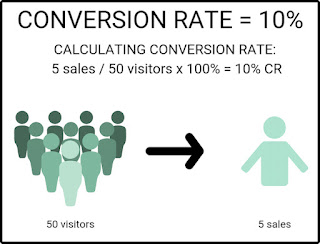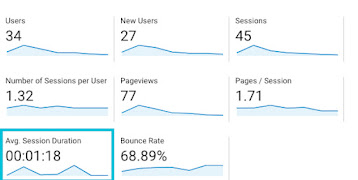Conversion Rates: What Are They and Why Do They Matter to Your Business?
What are Conversion Rates?
Conversion
rates are a crucial metric for any business owner to measure on their website.
A conversion occurs anytime a website visitor performs a specific action.
Conversions are usually tied to call to action such as; asking a website
visitor to sign up for a newsletter, download a PDF, install an app, make a
purchase or order a free trial. A conversion rate measures the success of a
specific campaign by calculating the percentage of users who performed the
conversion associated with the specific campaign. A marketer would measure the
total numbers of users who performed the desired and action and divide this by
the total audience they intended to target to calculate conversion rate
(Adjust, n.d.). Figure 1 below illustrates how a conversion rate would be
calculated for a business whose campaign goal was purchase conversions and a
target audience of 50.
Figure 1: Conversion Rate Calculation
(Madhuranjan, n.d.)
It’s
obvious to any business owner that converting an online visitor to a purchasing
customer is important, that is in most cases, the desired end result.
Conversion rates, however provide more information than just sales figures.
Conversion rates can help measure the effectiveness of marketing campaigns with
actions that lead the consumer closer to making a purchase. Actions such as
filling out a contact form, requesting a quote, or downloading a whitepaper are
all important to measure as these are conversions that lead to sales for the
business. By measuring conversion rates, marketers can make key observations to
optimize online ads, improve visuals on landing pages, create call to actions
that convert, improve web design to maximize results, choose the right channels
for distribution content and ads, target the right audience and many more
actions that can help increase conversation rates. Measuring these rates
provides the details to help a marketer choose which of these steps to take to
improve conversion.
Improving Conversions by A/B Testing Call to Action Button Color: Real World Example
Many
factors can be tested to optimize conversion rates, including design elements,
wording, and color. In the following example, marketers used A/B testing on the
color of the call to action button for website of Performable to determine if
changing the color lead to more conversions. Figure 2 below shows the changes
that were made, all content on the webpage remained the same, and the only
change that was made was the color on the call to action button.
Conclusion
Conversion
rate is a great measure for a business to determine the effectiveness of
campaigns as well as ways they can improve a webpage to increase conversions.
The Performable example shows how easy it is to make improvements to marketing
efforts by just measuring web analytics, specifically conversion rates. In the
example, additional advertising was not necessary to increase traffic to the
website, they were able to improve conversions by just improving the page
itself.
References
Adjust. (n.d.). What is a
CONVERSION? Why are conversions important? Adjust. https://www.adjust.com/glossary/conversion/.
Madhuranjan. (n.d.). Good
conversion rate on facebook: How to improve it. Good conversion rate on
Facebook | how to Improve it. https://www.vianinja.com/Good-conversion-rate-on-Facebook-how-to-improve-it.html.
Main Street ROI. (2020,
June 10). Marketing 101: Why conversion is key to your success. Main
Street ROI.
https://www.mainstreetroi.com/marketing-101-why-conversion-is-key-to-your-success/.
Porter, J. (2017, February
1). The button Color A/B Test: Red Beats green. HubSpot Blog.
https://blog.hubspot.com/blog/tabid/6307/bid/20566/the-button-color-a-b-test-red-beats-green.aspx.





It is interesting that by testing elements on the page, you can achieve better results. We did that quite a bit at Lowe's where we place the CTA buttons for our programs in different places to see what worked the best.
ReplyDelete